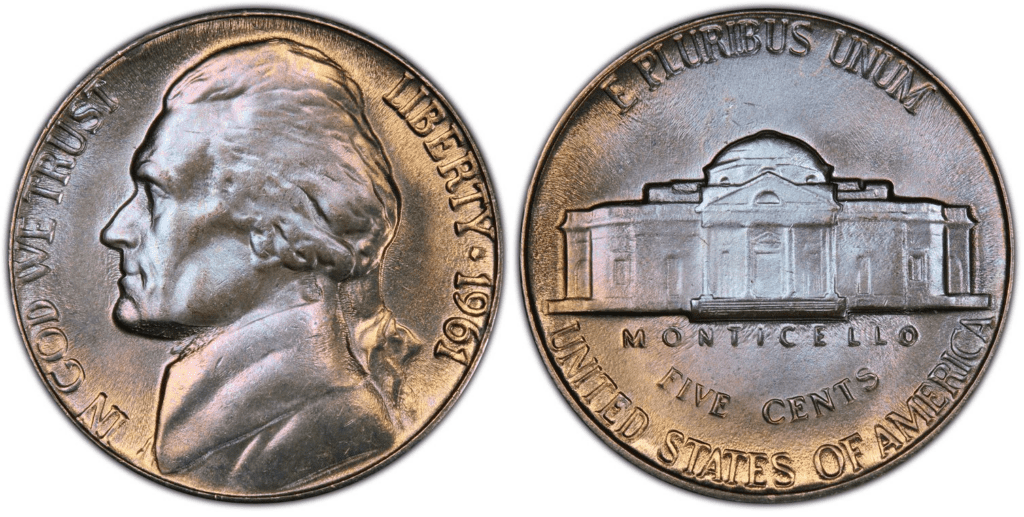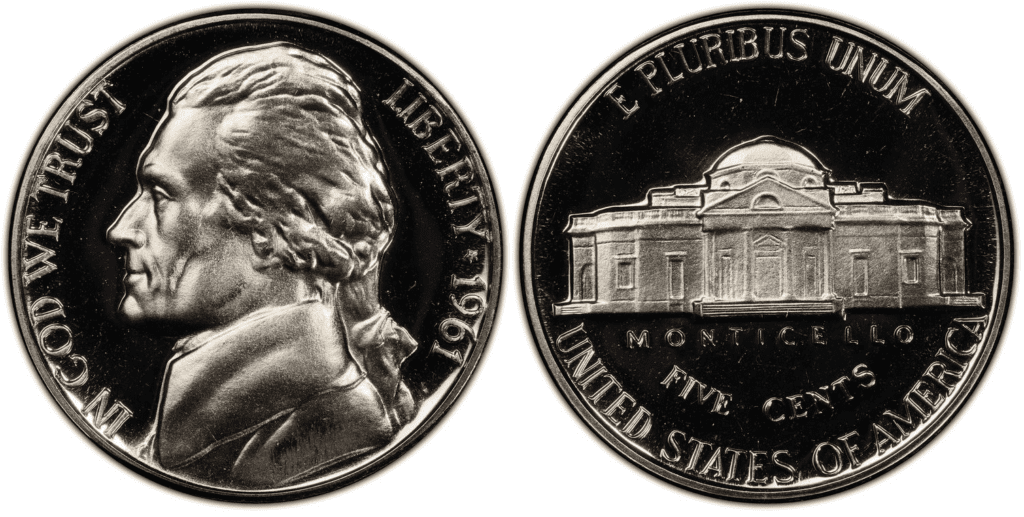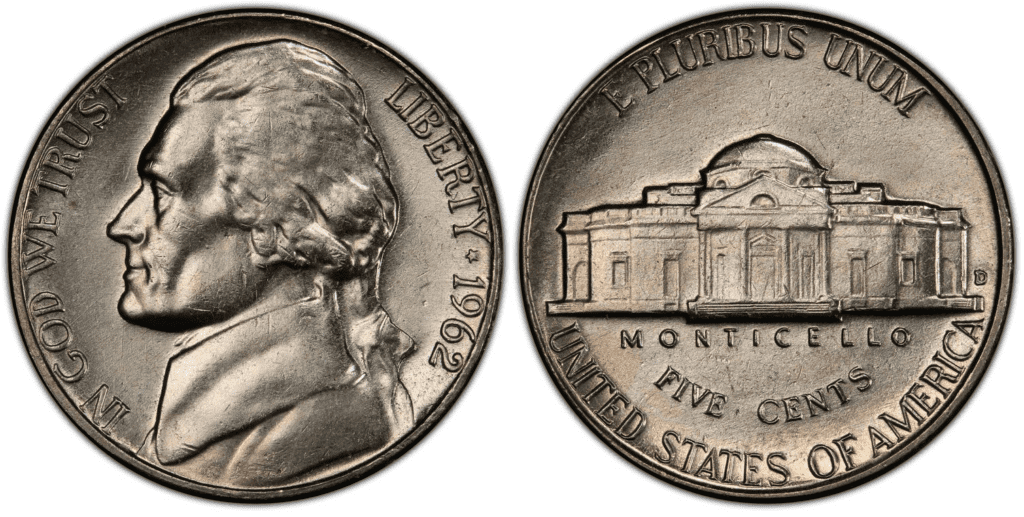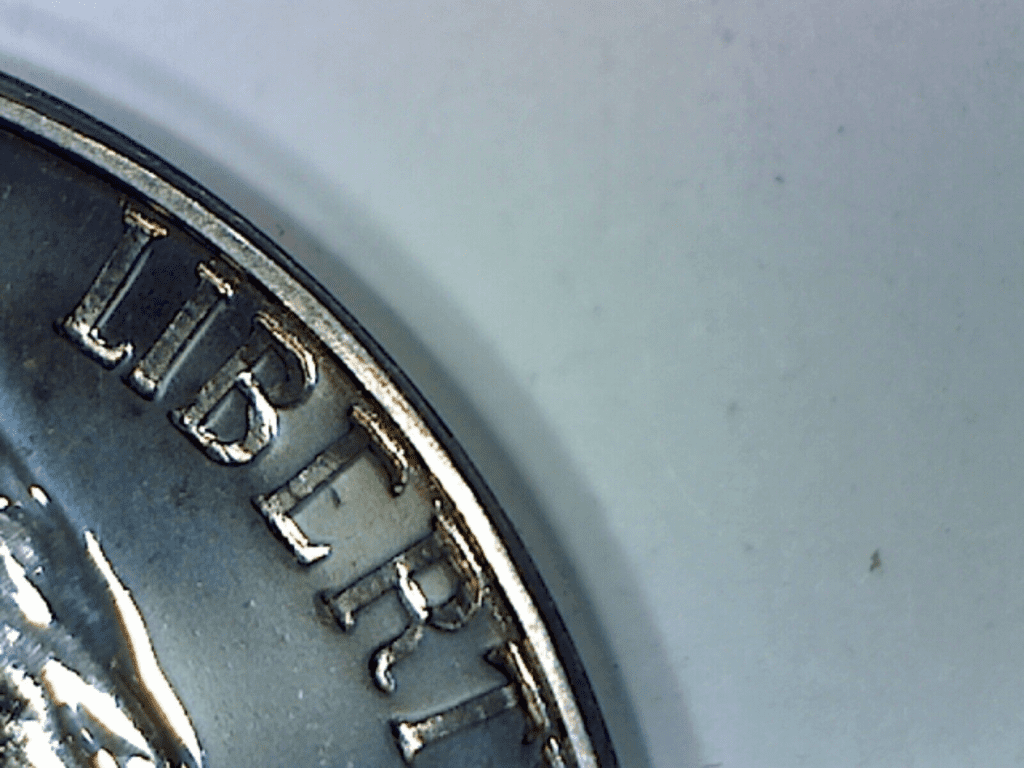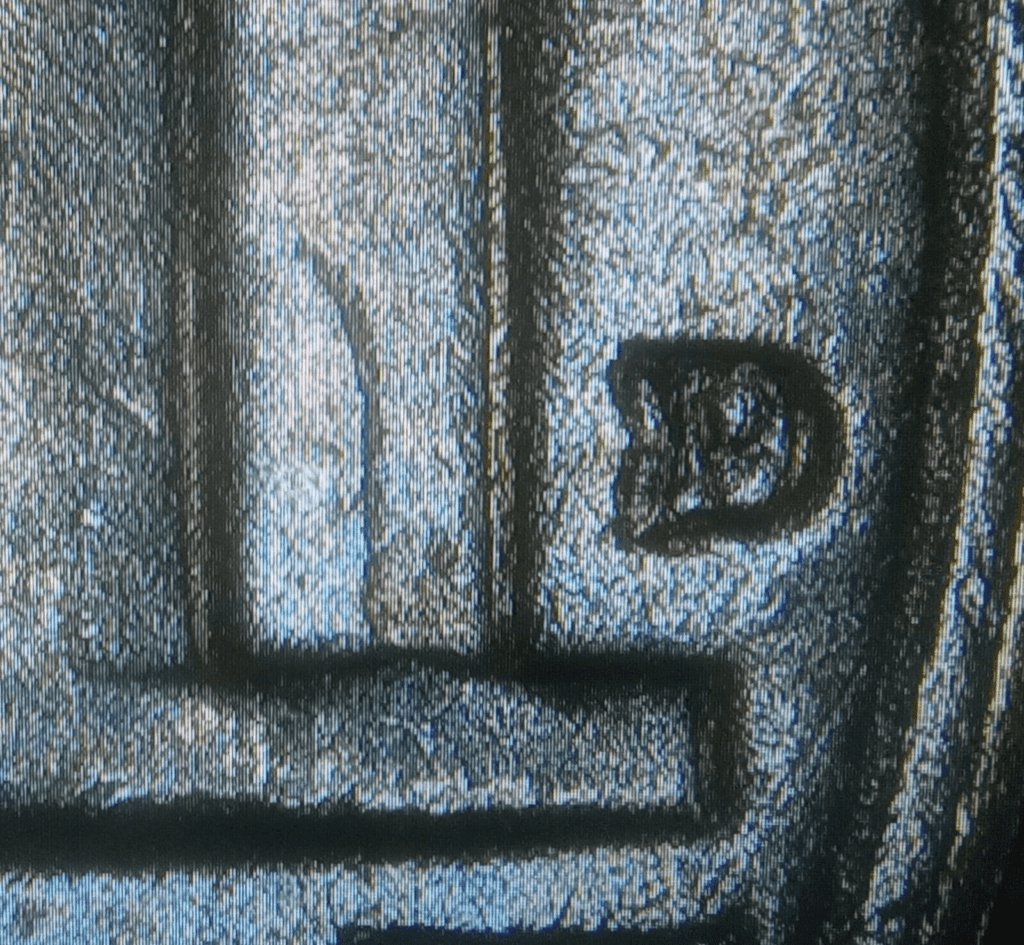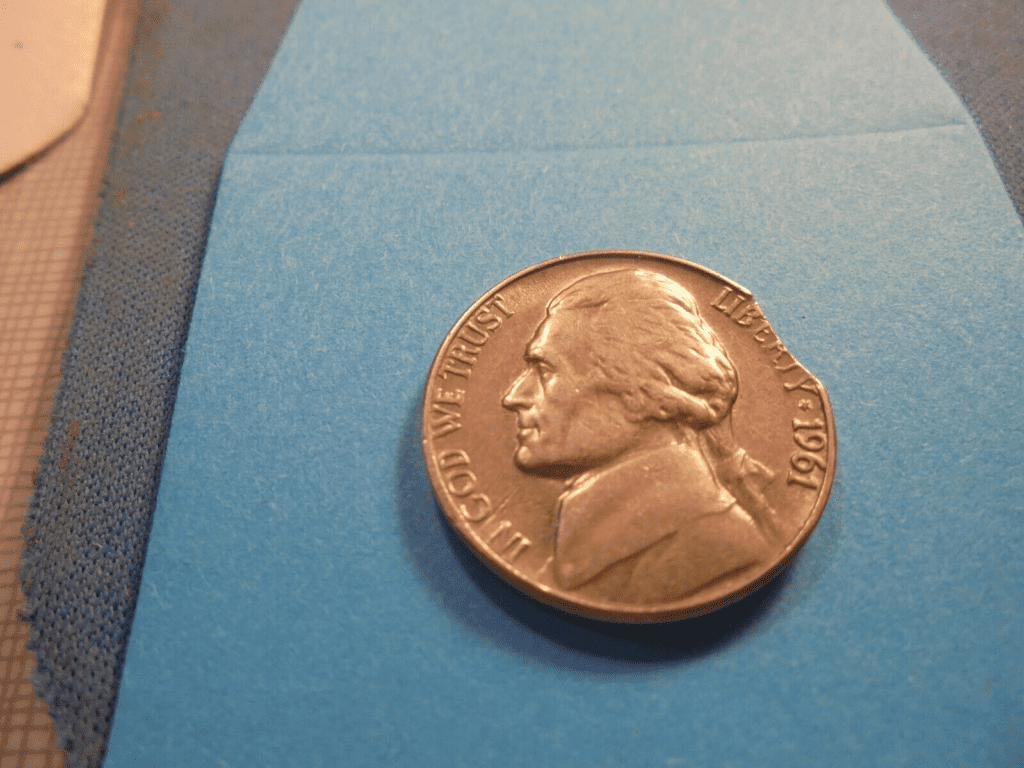What Is the 1961 Jefferson Nickel Made Of?
The 1961 Jefferson nickel is made of 75 percent copper and 25 percent nickel. From mid-1942 to 1945, the Jefferson nickel was made of 9% manganese, 35% silver, and 56% copper. These nickels were referred to as “war nickels.” The US Mint needed to adjust the composition of the coins at that time because copper and nickel were important raw materials needed for war.
The 1961 Jefferson nickel is just one of the Jefferson nickel series. The Jefferson nickel was first struck in 1938 and has been the type of nickel issued to this day.
The Jefferson nickel replaced the Buffalo nickel, which is something the US Mint wanted to do for a long time. While the Buffalo nickel comes with a nice design, it is not easy to produce. Its die easily broke and constantly needed to be replaced. So, when the Buffalo nickel can be legally changed, the US Mint chose Thomas Jefferson to be the next face of the nickel coin.

photo source: USA Coin Book
When it comes to design, the Jefferson nickel features the image of Thomas Jefferson, the third president of the United States and one of the Founding Fathers. The inscriptions include the US motto, IN GOD WE TRUST, LIBERTY, and 1961.
On the reverse, you’ll find the Monticello Mansion, the home of Thomas Jefferson. On top of the coin arches the US motto, “E PLURIBUS UNUM,” which means “Out of many, one.” The name of Monticello is also engraved. Other inscriptions include UNITED STATES OF AMERICA and FIVE CENT.
1961 Jefferson Nickel Varieties
The 1961 Jefferson Nickel comes with three main varieties: 1961 P Jefferson nickel, 1961 P Jefferson proof nickel, and 1961 D Jefferson nickel.
Aside from the standard varieties of the 1961 Jefferson nickels, there are also those that have errors in them, giving rise to a different type of coin.
Here are the 1961 Jefferson nickel varieties that you should know:
1961 P Jefferson nickel
Edge: Smooth
Mint Mark: No mint mark
Place of minting: Philadelphia
Year of minting: 1961
Face Value: $0.05 (fifty cents)
Price: $0.05 to $489 (or more)
Quantity produced: 73,640,100
Designer: Felix Schlag
Composition: 75% copper and 25% nickel
Mass: 5 grams
Diameter: 21.21 mm
Thickness: 1.95 mm

photo source: PCGS
The 1961-P Jefferson nickel was struck in the Philadelphia Mint. There’s no mint mark and the average price ranges from $0.05 to $10.00 but some coins could reach hundreds of dollars.
1961 P Jefferson nickel (proof)
Edge: Smooth
Mint Mark: No mint mark
Place of minting: Philadelphia
Year of minting: 1961
Face Value: $0.05 (fifty cents)
Price: $0.05 to $78.00 (or more)
Quantity produced: 3,028,144
Designer: Felix Schlag
Composition: 75% copper and 25% nickel
Mass: 5 grams
Diameter: 21.21 mm
Thickness: 1.95 mm

photo source: PCGS
The 1961-P proof Jefferson nickel was also struck in the Philadelphia Mint. The mint mark is absent. The average price ranges from $0.05 to $78.00.
Proof coins are more attractive, shinier, and more detailed. The production process is different. For example, most proof coins are struck harder. These coins are struck twice as well to really add details to the surface of the coin.
1961 D Jefferson nickel
Edge: Smooth
Mint Mark: D
Place of minting: Denver
Year of minting: 1961
Face Value: $0.05 (fifty cents)
Price: $0.05 to $45.00 (or more)
Quantity produced: 229,342,760
Designer: Felix Schlag
Composition: 75% copper and 25% nickel
Mass: 5 grams
Diameter: 21.21 mm
Thickness: 1.95 mm

photo source: PCGS
The 1961-D proof Jefferson nickel was struck in the Denver Mint. You’ll find the “D” mint mark between the right side of the Monticello and the edge of the coin. The average price ranges from $0.05 to $78.00. The Denver Mint produced the most number of 1961 nickels reaching more than 229 million.
List Of 1961 Jefferson Nickel Errors
At the end of 1961, there were more than 306 million Jefferson nickels produced by the US Mint. Error coins weren’t that common. However, it did happen every now and then. With millions of nickels in 1961, there was always the chance that a minting error would happen.
Now, minting errors can happen due to various reasons. However, the most common reason would be due to mechanical and equipment issues.
An example would be the doubled die error. This happens when a coin is struck twice by the die. In most cases, this error isn’t too pronounced. In fact, you would need a magnifying glass or microscope to see this error.
However, if you find a Jefferson nickel with an obvious doubled-die error, your coin could be worth a few more dollars.
There are times when the die didn’t hit the coin hard enough to the point that there are a few engraved elements that weren’t too pronounced.
Here’s an example:

photo source: eBay
You can see here that the letter E in the word Liberty isn’t completely engraved.
You might also see an RPM error. This means repunched mint.Mint marks are normally punched into the coin once. However, due to mechanical error, the punch might hit twice. Here’s an example of an RPM error:

photo source: eBay
Errors may also happen during the cutting of the planchet. This is called the lamination error where the planchet flakes or cracks.
Here’s an example:

photo source: eBay
Another planchet error is when the planchet was improperly cut. Sometimes, the planchet gets folded, shredded, or clipped. Here are some examples:

photo source: eBay
An example of a shredded planchet.

photo source: eBay
An example of a clipped planchet.
Other examples of errors that might have affected the minting of the 1961 Jefferson nickels include the following:
- Off-center strikes
- Broadstrikes
- Rotated dies
- Cracked dies
How Much Is 1961 Jefferson Nickel Worth Today?
The 1961 Jefferson nickel isn’t worth that much if you base it on its face value, which is only $0.05. The melt value is also low at $0.0628.
As this might be the case, the 1961 Jefferson nickels are still valuable provided they are in good condition. Even coins with errors are considered to carry a high premium.
To give you an example, here’s a 1961 Jefferson Nickel values chart:
| Coin | Condition | Grade | Mintage | Value |
| 1961 P Jefferson Nickel | Circulated/mint | Not graded | 73,640,100 | $0.05 to $489 |
| 1961 P Jefferson Nickel | Uncirculated/mint | MS-64 | 73,640,100 | $489 to $1,320 |
| 1961 P Jefferson Nickel | Uncirculated/mint | MS-65 | 73,640,100 | $2,340 to $3,220 |
| 1961 P Jefferson Nickel | Uncirculated/mint | MS-66 | 73,640,100 | $2,300 to $10,800 |
| 1961 P Jefferson Nickel (Proof) | Uncirculated/proof | Not graded | 3,028,144 | $0.05 to $78 |
| 1961 P Jefferson Nickel (Proof) | Uncirculated/proof | MS-66 | 3,028,144 | $32 to $70 |
| 1961 P Jefferson Nickel (Proof) | Uncirculated/proof | MS-67 | 3,028,144 | $45 to $110 |
| 1961 P Jefferson Nickel (Proof) | Uncirculated/proof | MS-68 | 3,028,144 | $78 to $324 |
| 1961 D Jefferson Nickel | Circulated/mint | Not graded | 229,342,760 | $0.05 to $45.00 |
| 1961 D Jefferson Nickel | Uncirculated/mint | MS-64 | 229,342,760 | $8,050 to $11,163 |
| 1961 D Jefferson Nickel | Uncirculated/mint | MS-65 | 229,342,760 | $14,688 to $23,000 |
As you can see, there are 1961 nickels that are worth hundreds and even thousands of dollars.
Just to give you an example, a 1961-D Jefferson nickel was sold for $23,000 during an auction held by Bowers & Merena. It was sold in August 2004.
How Does The Grading System Work?
The Sheldon Scale is used by numismatists to provide a numerical value to coins. The Sheldon Scale goes from poor (P-1) to perfect mint state (P-1) (MS-70). Coins were originally evaluated using words to reflect their condition (Good, Fair, Excellent, Etc.). Unfortunately, coin collectors and dealers had different ideas about what each of these terms represent.
Professional numismatists joined together in the 1970s and established CoinGrading standards. These numismatists now assign grades at key places on the seventy-point scale, using the most regularly utilized numeric points in conjunction with the original adjective grade. The following are the most common coin grades:
-
-
- (P-1) Poor – Indistinguishable and probably damaged; if used, must have a date and mintmark; otherwise, rather battered.
- (FR-2) Fair – Nearly smooth, but without the damage that a coin graded Poor often possesses. The coin must have enough detail to be identified.
- (G-4) Fair – Inscriptions have merged into the rims in some areas, and important elements have been mostly erased.
- (VG-8) Very Good- A little weathered, but all of the primary design elements are visible, albeit faintly. There is little if any, central detail left.
- (F-12) Good – The item is very worn, yet the wear is even, and the overall design details stand out clearly. Rims are almost completely isolated from the field.
- (VF-20) Very Fine – Moderately weathered, with some finer features still visible. The motto or all letters of LIBERTY are readable. Both sides of the coin have entire rims that are separated from the field.
- (EF-40) Extremely Fine – Gently used; all gadgets are visible, and the most important ones are bold. The finer details are bold and clear, however, light wear may be seen.
- (AU-50) Uncirculated – Slight evidence of wear on the coin’s design’s high points; may have contact marks; eye appeal should be adequate.
- (AU-58) Uncirculated Choice – Slight traces of wear, no severe contact marks, almost full mint shine, and great eye appeal.
- (MS-60) Mint State Basal – Strictly uncirculated; no indication of wear on the coin’s highest points, but an unsightly coin with reduced luster, visible contact marks, hairlines, and other flaws.
- (MS-63) Mint State Acceptable – Uncirculated, but with contact scratches and nicks, little reduced shine, but otherwise appealing appearance. The strike is weak to average.
- (MS-65) Mint State Choice – Uncirculated with great mint shine, very little contact blemishes, and exceptional eye appeal. The strike is unusually severe.
- (MS-68) Mint State Premium Quality – Uncirculated with superb luster, no obvious contact marks to the naked eye, and exceptional eye appeal. The strike is quick and appealing.
- (MS-69) Almost Perfect Mint State – Uncirculated with perfect brilliance, a sharp and appealing strike, and extremely good eye appeal. A near-perfect coin with minor imperfections in the planchet, strike, and contact markings (seen only under 8x magnification).
- (MS-70) Mint State Perfect – Under 8x magnification, there are no tiny imperfections discernible; the strike is crisp, and the coin is perfectly centered on a beautiful planchet. Rarely seen on a coin, this coin is bright and whole, with original luster and exceptional eye appeal.
-
Where To Buy Or Sell 1961 Jefferson Nickel?
The 1961 Jefferson nickel should be readily available online and in mortar-and-brick stores. For example, you can go to Amazon, eBay, and Etsy to buy or sell 1961 Jefferson nickels. You can even search for rare coins on social media such as Facebook, Instagram, Whatsapp, and others. A simple Google search will also give you a list of websites that specialize in selling and buying coins such as the 1961 nickels.
Aside from the Internet, you can join coin auctions. You can also visit pawn shops, coin shops, and antique stores. Get in touch with local or national clubs or groups of coin collectors. They should be able to give you more details about where to buy or sell 1961 5-cent coins.
FAQs
How much is a 1961 nickel proof worth?
On average, the 1961 nickel-proof coins are worth around $0.28 to $23. However, there are nickel proof coins that are worth more. To give you an example, PCGS noted an auction record of a 1961 deep cameo proof nickel coin, which was sold for $3,407.50 in an auction held by the Legend Rare Coin Auctions in September 2021.
How can I tell if my 1961 Jefferson D Nickel is an error or not?
The first thing you can do is do a visual check. Look for unusual engravings, colors, and shapes. Some errors should be easy to spot. You can use a camera that can zoom closely into your coin or a magnifying glass to further examine the coin. If you want to be sure, feel free to get in touch with coin grading service providers. They should be able to give you a more decisive answer whether your 1961 Jefferson D nickel has an error or not.
Is there a star over the “L” in Liberty in 1961 Nickel?
Normally, there is no star over the “L” in the word Liberty on the obverse side of the 1961 nickel. However, if you see one, it might be a minting error caused by a strike-through error.


